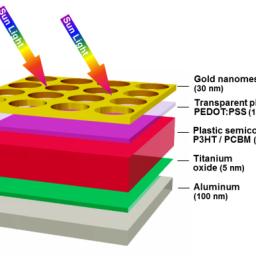Nanotechnology could lead to better, cheaper LEDs
 Considering how ubiquitous LEDs are becoming in our gadgets, phones, and even ambient lighting, it's good to look for efficiencies and process improvements in their manufacture. Princeton University researchers have developed a new method to increase the brightness, efficiency and clarity of LEDs, which may lead to big changes in this technology.
Considering how ubiquitous LEDs are becoming in our gadgets, phones, and even ambient lighting, it's good to look for efficiencies and process improvements in their manufacture. Princeton University researchers have developed a new method to increase the brightness, efficiency and clarity of LEDs, which may lead to big changes in this technology.Although they are known for their efficiency, only about 38 percent of light generated inside an LED actually escapes, due to hitting the envelope of the LED at an angle of incidence greater than the critical angle. The trapped light (called total internal reflections) also heats the LED, which greatly reduces its lifespan.
The solution presented by Chou's team at Princeton University is the invention of a nanotechnology structure called PlaCSH (plasmonic cavity with subwavelength hole-array). The researchers reported that PlaCSH increased the efficiency of light extraction to 60 percent. Chou and his team are now conducting experiments to demonstrate PLaCSH in red and blue organic LEDs, in addition the green LEDs used in the current experiments.
This reported breakthrough appears strikingly similar to one from the University of Glasgow in 2007, similarly reporting the use of cost-effective nanotechnology processes to greatly improve efficiency of LEDs.
PlaCSH technology was first announced two years ago, reported to offer a 175 percent efficiency improvement to photo-voltaic solar cells, additionally reducing the thickness of the silicon used in traditional solar panels by a thousand-fold, while also being cost-effective to manufacture.
The mention of PlaCSH solar cells being developed before, that I've never heard of, made me want to know if anything came of it, and perhaps how close to the promised numbers were products realizing in production. A search for PlaCSH didn't immediately turn-up hits on well-known reputable sites, but instead mostly sites with "UFO" and "alternative energy" in their names (no joke). While this research is from Princeton, funded by DARPA and the NSF, that's still a red flag...
Found this source from a few years ago, claiming only a mere 20% is lost in LED light extraction, not TFA's claimed 62%:
http://www.edn.com/electronics-blogs/powersource/4307926/LED-inefficiencies-82-of-lighting-energy-lost-as-heat
And I don't know what's up with the double-link to TFA.